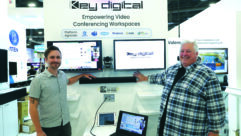
Digital Educator Program Benefits from AV Donation
Mar 4, 2009 12:00 PM,
By Linda Seid Frembes

Epson PowerLite W6
For a K-12 teacher, gathering multimedia content and using interactive technology to interest students in learning can be a tough task. Teachers must somehow master the use of computers, whiteboards, and projectors to present content in addition to providing fundamental knowledge of the subject matter to their students. Teachers in Florida have a resource called the Florida Digital Educators (FDE), which provides training to educators in K-12 schools on how to integrate technology into their curriculum.
According to the FDE, its mission is to “enable students to achieve world-class standards by transforming the learning environment through professional education, follow-up mentoring and support, use of digital tools for the creation of content, the development of collaborative communities, and rigorous evaluation and research activities.” That means that based on the training provided, teachers will be able to integrate technology as a means to engage students in the classroom.
The traveling Master Digital Educators staff at the FDE recently got a big helping hand from a donation of 10 Epson PowerLite W6 multimedia projectors and 10 PolyVision eno interactive whiteboards. “PolyVision had a presence in Florida for a while so when we got the call, we were glad to join in and help,” says Daniel Oey, group product manager for strategic markets and new business at Epson America. “The model of the program is that these trainers are the teachers of the teachers. The PowerLite W6 met the needs of the program because the trainers would be traveling; it is lightweight with all the features they would need.”
At an estimated retail price of $799, the Epson PowerLite W6 projector has WXGA resolution and a 16:10 aspect ratio, which perfectly fits the PolyVision eno interactive whiteboard. The projector accommodates widescreen laptops and can accurately display widescreen movies or other content—a benefit that Epson contends is a future-proofing aspect to the product since more schools are moving to widescreen.
According to Epson, the projector also offers USB video, VGA video, and HDMI connectivity for high-definition-quality video. Digital audio is broadcast through its 7W speaker. Users also have the option of simplified projection through USB Plug n’ Project connectivity for quick, on-the-spot projection. The bright PowerLite W6 has 2000 lumens white light output and 2000 lumens color light output.
1
Digital Educator Program Benefits from AV Donation
Mar 4, 2009 12:00 PM,
By Linda Seid Frembes
When coupled with the PowerLite W6, the PolyVision eno is a powerful tool for these trainers who are constantly on the go and setting up in various room configurations. PolyVision bills the eno as the first three-in-one interactive whiteboard solution because it behaves like a dry-erase marker board, a magnetic board, and a multimedia surface all in one. The board can also be moved from location to location without cumbersome cables or power hookups. According to the company, the eno provides interactivity via a Bluetooth-enabled stylus that requires no hard connection to power or data, and therefore no extra training for teachers.
The virtually indestructible board also offers a green benefit since its e3 environmental ceramicsteel surface has Cradle to Cradle Silver certification from McDonough Braungart Design Chemistry (MBDC). The Cradle to Cradle certification ensures that the product uses environmentally safe materials and is designed for recycling or composting and energy efficiency.
Another green aspect to the donation is Epson’s proprietary lamp technology called Epson Twin Optimized Reflection Lamp (E-TORL). “It is an optical assembly with more efficiency so you can run the lamp longer and cooler, amounting to cost savings over time,” Oey says, referring to the elliptical (versus parabolic) reflector in the assembly.
According to Epson, using E-TORL technology means that lamp life can last up to 4000 hours in economy mode, up to 50 percent longer than competitively priced models. The company also notes that replacement E-TORL lamps cost up to $150 less than competing replacement lamps. Sources say that the E-TORL design gives the projector a 20 percent improvement in efficiency by redirecting errant lights onto the optics and by reducing waste heat.
Oey says the PowerLite W6 is more like a traditional projector and that, in a classroom install, teacher would most likely have a PowerLite 400W multimedia projector instead. According to Oey, the 400W is a short throw projector that can be mounted close to the wall, which saves space and reduces glare from the board. The 400W also have networking support capability so administrators can monitor lamp life. “The key is that Epson is the leader in the market,” Oey says. “We have a range of product with unique features that fit whatever the market needs.”
2










